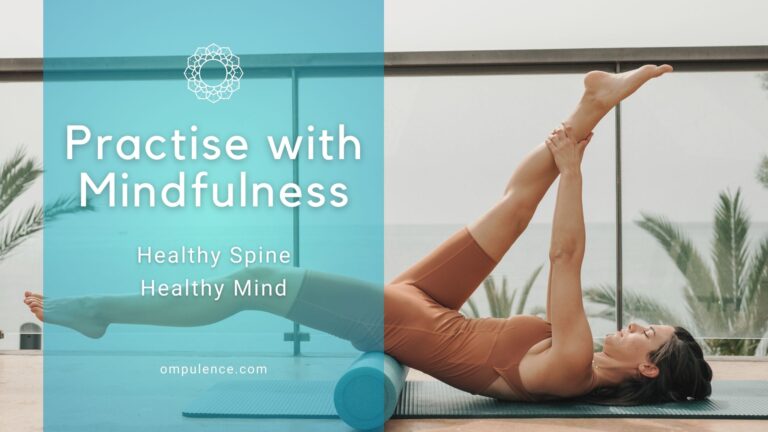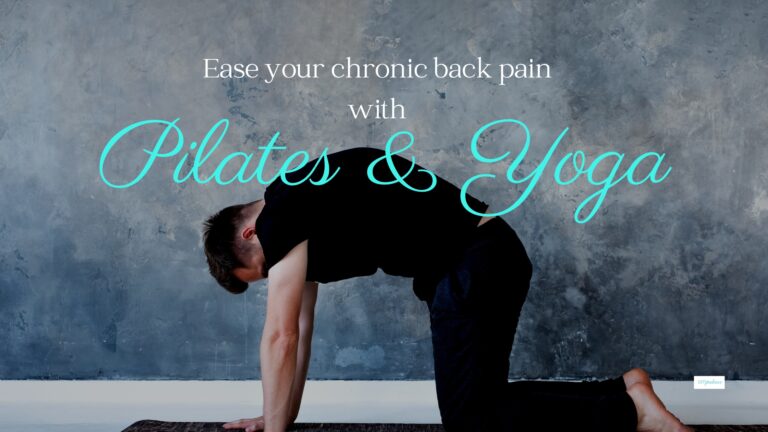Pilates Mat Class: A Professional & Accessible Solution for Chronic Back and Neck Pains
Pilates is a form of exercise that focuses on strengthening the core muscles, improving flexibility, and promoting overall body alignment. It was originally developed by Joseph Pilates in the early 20th century as a rehabilitation tool for injured dancers and soldiers. Today, Pilates is widely recognized as a safe and effective way to improve posture, reduce stress, and alleviate chronic pain. In particular, Pilates mat classes can be an excellent option for those with back and neck pain, as they provide a low-impact exercise that is gentle on the joints while still challenging the muscles.
If you suffer from chronic back and neck pain, you know how debilitating it can be. Even simple tasks like sitting at a desk or standing for too long can become unbearable. Prescription painkillers and physical therapy may provide temporary relief, but they often come with unwanted side effects or require a significant time commitment. Fortunately, there may be a solution that is both effective and accessible: Pilates mat classes.
Understanding Chronic Back and Neck Pains
Causes of Chronic Pain
Chronic back and neck pains can be caused by various factors such as poor posture, muscle strain, injury, and degenerative conditions like arthritis. Other factors that contribute to chronic pain include stress, lack of exercise, and obesity.
Poor posture can cause chronic pain as it puts unnecessary strain on the muscles and joints. Similarly, muscle strain caused by overuse or sudden movement can lead to chronic pain. Injuries like sprains, fractures, and herniated discs can also cause chronic pain if not treated properly.

Benefits of Pilates for Pain Relief
Pilates is a low-impact exercise that can help alleviate chronic pain. It focuses on strengthening the core muscles, improving posture, and increasing flexibility. By doing Pilates, you can improve your body’s alignment, which can reduce the strain on your muscles and joints.
Pilates exercises can also help to stretch and strengthen the muscles in your back and neck, which can provide relief from chronic pain. Additionally, Pilates can help to reduce stress and tension, which can exacerbate chronic pain.
Overall, Pilates can be an effective way to manage chronic back and neck pains (provided that you are learning from qualified instructors that focus on teaching you the fundamentals clearly). However, it is important to consult with a healthcare professional before starting any new exercise program, especially if you have a pre-existing condition.
Principles of Pilates for Pain Management
If you suffer from chronic back and neck pains, Pilates mat class may be just what you need to alleviate your discomfort. Pilates is a low-impact exercise that can help improve your posture, strengthen your core muscles, and increase your flexibility. Here are some principles of Pilates that can help manage pain:
1. Concentration
Pilates requires you to be fully present during your practice. By focusing on your movements and breathing, you can increase your body awareness and reduce stress. This can help alleviate tension in your back and neck muscles, which can contribute to pain.
2. Control
Pilates emphasizes controlled movements that engage your core muscles (tranversus abdominis). By strengthening your core, you can improve your posture and reduce strain on your back and neck. This can help alleviate pain and prevent future injuries.

3. Precision
Pilates movements require precision and attention to detail. By performing exercises correctly, you can target specific muscles and avoid putting unnecessary stress on your back and neck. This can help reduce pain and prevent further injury.
4. Breath
Breathing is an important aspect of Pilates. By coordinating your breath with your movements, you can increase your oxygen intake and reduce tension in your body. This can help alleviate pain and promote relaxation.
5. Flow
Pilates movements are designed to flow smoothly from one to the next. By moving with grace and fluidity, you can improve your flexibility and reduce tension in your muscles. This can help alleviate pain and improve your overall well-being.
By incorporating these principles into your Pilates mat class, you can manage your back and neck pain and improve your overall health and fitness.
Essential Pilates Mat Exercises
If you suffer from chronic back and neck pains, Pilates mat exercises can be an effective way to alleviate discomfort and improve your overall posture. Here are some essential Pilates mat exercises that can help you achieve these goals:
Warm-Up Movements
Before you start your Pilates mat class, it’s important to do some warm-up movements to prepare your body for the exercises ahead. These movements will include proper breathing practice and spinal warm ups.
Core Strengthening
Pilates mat exercises focus heavily on core strengthening and spinal articulation, which can help to improve your posture and alleviate back pain. Some of the best core-strengthening exercises include:
- The Hundred: Lying on your back with your legs in a tabletop position, pump your arms up and down while engaging your core muscles for 100 counts.
- Plank: Start in a push-up position with your arms straight and your body in a straight line, and hold for 5 seconds to 30 seconds (depending on your strength and ability to hold comfortably, without tensing).
- Leg Circles: Lying on your back with your legs straight up in the air, make small circles with your legs to engage your core muscles and improve your hip mobility.
Spinal Alignment
Proper spinal alignment is crucial for reducing back and neck pain, and Pilates mat exercises can help you achieve this. Some of the best spinal alignment exercises include:
- Spine Stretch: Sitting up tall with your legs straight out in front of you, reach forward and stretch your spine as far as you can while keeping your shoulders relaxed.
- Swan: Lying on your stomach with your hands by your shoulders, lift your upper body off the ground while keeping your pelvis and legs on the mat to strengthen your back muscles.
Stretching Techniques
Stretching is an important part of any Pilates mat class, and can help to improve your flexibility and reduce muscle tension. Some of the best stretching techniques include exercises like scissors, spine stretch forward and mermaid.
By incorporating these essential Pilates mat exercises into your routine, you can improve your posture, alleviate back and neck pain, and enjoy a stronger, more flexible body.
Modifications for Pain Conditions
If you suffer from chronic back or neck pain, you may be hesitant to try Pilates mat classes. However, with the right modifications, you can still enjoy the benefits of Pilates while avoiding exacerbating your pain.
Adapting Exercises for Back Pain
When participating in Pilates with back pain, it’s important to focus on exercises that promote spinal alignment and stability. Here are some modifications you can make:
- Start with gentle warm-up exercises such as pelvic tilts and knee folds to loosen up your back muscles.
- Avoid exercises that require you to flex your spine, such as roll-ups and spine stretches. Instead, focus on exercises that maintain a neutral spine position, such as the plank and side plank.
- If you experience discomfort during exercises that require you to lie on your back with both legs up, such as the Hundred or double leg stretch, you can place your head on the mat, keep one foot down or extend your knee towards ceiling with slightly bend knees.
- Use props such as a yoga block, pilates ball or resistance band to modify exercises and decrease the load on your back muscles.
Adapting Exercises for Neck Pain
If you have neck pain, it’s important to avoid exercises that require you to lift your head off the mat or strain your neck muscles. Here are some modifications you can make:
- Start with gentle neck stretches and shoulder rolls to loosen up your neck muscles.
- Avoid exercises that require you to lift your head off the mat, such as the Roll-Up or the Teaser. Instead, focus on exercises that keep your head and neck in a neutral position, such as the Hundred or the Leg Circles.
- Use a folded towel to support your head and neck during exercises that require you to lie on your back, such as the Single Leg Stretch or the Double Leg Stretch.
- Use props such as a small ball or foam roller to support your practice.
Remember to listen to your body and modify exercises as needed. With these modifications, you can still enjoy the benefits of Pilates while avoiding exacerbating your pain.
Safety Guidelines and Precautions
When practicing Pilates mat exercises, it is important to keep in mind some safety guidelines and precautions to avoid any potential injuries or aggravation of chronic back and neck pains.
Here are some key points to keep in mind:
1. Consult with your healthcare provider
Before starting any new exercise program, it is important to consult with your healthcare provider, especially if you have chronic back and neck pains. They can advise you on whether Pilates mat exercises are appropriate for your condition and suggest modifications or precautions as needed.
2. Start slowly and gradually increase intensity
It is important to start slowly and gradually increase the intensity of your Pilates mat exercises. This will allow your body to adapt and avoid any sudden strain or injury. Listen to your body and stop if you experience any pain or discomfort.
3. Use proper form and alignment
Proper form and alignment are crucial to avoid any unnecessary strain on your back and neck. Pay attention to your instructor’s cues and use mirrors or video recordings to check your form. Engage your core muscles and avoid overarching or rounding your spine.
4. Modify exercises as needed
If you experience any pain or discomfort during a Pilates mat exercise, modify it to suit your needs. Your instructor can suggest modifications or alternatives that will allow you to continue practicing safely.
5. Avoid exercises that aggravate your condition
If you have chronic back and neck pains, there may be certain Pilates mat exercises that aggravate your condition. Avoid these exercises or modify them as needed. Your instructor can suggest alternatives that will allow you to continue practicing safely.
By following these safety guidelines and precautions, you can enjoy the benefits of Pilates mat exercises for chronic back and neck pains while minimizing any potential risks.

Progress Tracking and Pain Management
When it comes to managing chronic back and neck pains, tracking your progress is crucial. In Pilates mat class, you will learn various exercises that can help alleviate your pain and improve your posture. By keeping track of your progress, you can monitor your improvement and make necessary adjustments to your routine.
Pilates mat class instructors may use tools such as posture analysis to help track your progress. By analysing your posture, your instructor can identify areas where you may need to focus more on strengthening or stretching.
It’s important to remember that progress may not happen overnight. Consistency is key in managing chronic pain. By attending Pilates mat class regularly and tracking your progress, you can gradually improve your pain and overall quality of life.
In addition to tracking your progress, pain management techniques can also be incorporated into your Pilates mat class routine. Breathing exercises, for example, can help calm the nervous system and reduce tension in the body. Your instructor may also guide you through exercises that target specific muscles that may be contributing to your pain.
By combining progress tracking and pain management techniques, Pilates mat class can be an effective tool in managing chronic back and neck pains.
Additional Resources and Support
If you are suffering from chronic back and neck pains, it is important to seek additional resources and support to help manage your condition. Here are some options to consider:
Physiotherapy
Physiotherapy can help to alleviate pain and improve mobility. A physiotherapist can work with you to develop a personalised exercise plan to target your specific needs. They can also provide hands-on treatment to help relieve pain and improve range of motion.
Massage Therapy
Massage therapy can help to reduce muscle tension and improve circulation. A qualified massage therapist can work with you to target specific areas of pain and tension, helping to relieve discomfort and improve overall wellbeing.
Chiropractic Care
Chiropractic care involves the manipulation of the spine to improve alignment and relieve pain. A chiropractor can work with you to develop a treatment plan that targets your specific needs and helps to improve overall spinal health.
Yoga
Yoga can help to improve flexibility, strength, and balance. It can also help to reduce stress and promote relaxation. Consider attending a gentle yoga class or working with a yoga instructor to develop a personalised practice that targets your specific needs.

Mindfulness Meditation
Mindfulness meditation involves focusing your attention on the present moment, without judgement. It can help to reduce stress and improve overall wellbeing. Consider attending a mindfulness meditation class or using a guided meditation app to help manage your chronic pain.
Remember, it is important to consult with your doctor before starting any new exercise or treatment program. They can help to ensure that you are receiving the appropriate care for your specific needs.
I am Carol (principal instructor and founder of Ompulence Mindful Movements). I have been teaching pilates matwork for more than 20 years, helping people to enhance their spinal health and mental well being. Please join me in the mindful pilates mini course. Kickstart your healing journey with me. Click here to learn more.
Healthy spine, healthy mind.
Inhale…exhale…





